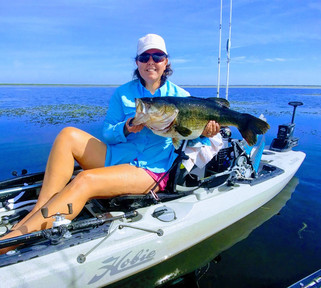
The FWC's TrophyCatch program ended another successful season this past quarter as the final Season 8 submissions were reviewed! The TrophyCatch team was thrilled to recognize the anglers who submitted 22 Hall of Fame bass weighing 13 pounds or more that were caught, documented, and released back into Florida’s waters. Furthermore, Rodman Reservoir had 157 approved trophy bass making it the top producing water body of the season. With the opening of Headwaters Boat Ramp on Fellsmere Reservoir in August of last year, the waterbody was TrophyCatch’s number two top producing waterbody for Season 8 and had 56 approved bass during the year (see photo).
TrophyCatch has awarded prizes for the catch and release of more than 10,000 largemouth bass since the program began in 2012. Through Season 8, a total of 8,530 Lunker Club, 2,086 Trophy Club and 89 Hall of Fame fish contributed to this landmark occasion. TrophyCatch anglers have collectively caught and released over 97,500 pounds of bass.
|
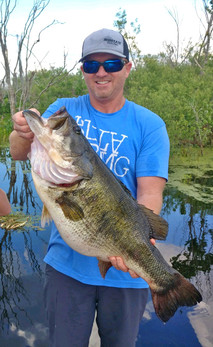
Others wins for TrophyCatch this season include seven Hall of Fame bass coming from Hillsborough County. Prior to this season, the county had only contributed one other Hall of Fame fish. Additionally, three Hall of Fame fish came from historic Orange Lake (see photo) located in Marion County. It is now in its fishing prime following a natural drawdown in 2011 and subsequent habitat enhancement actions.
“We want to thank Bass Pro Shops and all of our partners and anglers for their commitment to the future of bass conservation,” said Tom Graef, FWC’s Director of the Division of Freshwater Fisheries Management. “The data we receive from TrophyCatch is crucial in making management decisions and will continue to do so. Florida anglers must remain a part of our research team for us to continue being the Bass Fishing Capital of the World.”
The TrophyCatch program rewards anglers who provide documentation of their catch and release of largemouth bass weighing 8 pounds or heavier in Florida. In order to be eligible for prizes, anglers are required to submit photos or videos of their catch to TrophyCatch.com, showing the entire fish and its weight on a scale, before releasing it back into the water. The FWC encourages anglers to join TrophyCatch to become citizen scientists and assist in the management and the conservation of Florida’s freshwater fisheries. The associated TrophyCare program promotes best handling practices for trophy bass to ensure that each TrophyCatch bass is released alive. We look forward to the current Season 9, especially as this quarter is likeliest to produce the season's best catches.
|

Size: To about 2 ½ inches long. Also commonly referred to as Gambusia after its scientific name. There is no Big Catch category for this small minnow and baitfish.
Identification and similar species: Note the one to three vertical lines on the tail. Also present is a distinct cross-hatching pattern on the body created by the scales. Females may possess a distinct black spot on the belly, and are usually larger than males. Melanistic (dark- pigmented) forms, either all or speckled black, are common. Other minnows, such as the least killifish and bluefin killifish, lack the vertically-striped tail. The most common exception, the sailfin molly, has a much larger dorsal fin. See The Florida Freshwater Angler Issue 10 for a Minnow Identifier with additional species.
Angling qualities: Mosquitofish are usually overlooked and not of much interest to anglers except as a baitfish. Though small, these minnows can be easily found and dipnetted. They make a fair bait for large bluegill, and smaller largemouth bass may also take them although Gambusia certainly do not compare with shiners as a bass bait. For aquarists, mosquitofish are the most readily available source, besides the pet store, of “feeder fish” for piscivorous aquarium residents.
Where to find them: The tiny mosquitofish is one of Florida's most abundant fish. It is often the first fish species to show up in a new body of water, or even temporary roadside puddles following rains. They are very quick to colonize new locations on the advancing edge of rising waters.
|

Interesting facts: Although they often go unnoticed, mosquitofish are a very important forage species for small bass and sunfish as well as wildlife including smaller herons and anhingas. The female’s eggs are fertilized internally by the male. The young are later born live, rather than from eggs as with most other Florida fish. Since mosquitofish do not share the same reproductive requirements as most other freshwater fish (correct bedding substrate available within a specific depth) they can be very successful in habitats less than ideal for the breeding needs of other species. These fish are sometimes stocked for mosquito control because, as their name implies, mosquito larvae represent one of their primary foods. Under the right conditions, their sheer numbers and high reproductive success in a variety of habitats can assist in effective mosquito control.
|
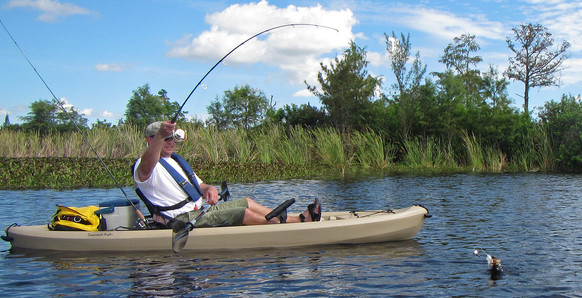 |
A knot is the weakest link in that fragile connection between angler and fish: the line. Who hasn’t reeled in a slack line following a violent strike or strong battle only to find the telltale curl of a slipped knot awaiting them at the end? The wrong tie can even cut a line’s strength in half! Thankfully, knowledge of only a few basic and easy knots will suffice most anglers for a lifetime of successful fishing.
Improved Clinch Knot
This is the angler’s most basic tie, useful for connecting monofilament to hook or lure.
1. Begin by passing the tag end (free end) of the line through the eye of the lure or hook. Next wrap the tag end around the standing end of the line at least five times. Fewer turns will allow the knot to slip. If necessary, use more turns for thick-wire eyes to prevent slipping.
2. Now pass the tag end through the loop in the line nearest the eye, then pass the tag end back through the loop you just created. Pull on the standing end (the line going back to the rod) to tighten, being careful that the wraps do not “pile up” under each other.
Blood Knot
Use this knot to connect two lines of equal diameter. (Not as hard to tie as the name suggests!)
1. Begin by laying the two lines alongside each other and wrapping one line around the other five times. Pass the tag end back between the two lines.
 2. Repeat the process with the other line. This tag end should also pass back between the two lines, but from the opposite direction as the tag end of the first line.
 3. Pull evenly on both standing lines to cinch up the knot. Make sure neither tag end slips out from between the two lines during tightening.
 Palomar Knot
This is an easy knot to tie that works pretty universally among various brands of braided line.
1. Pass the line through the hook eye and then back through again to form a loop.
2. Tie a simple square knot using the loop of line you just made . . .
3. Then, pass that same loop back over the hook or lure.
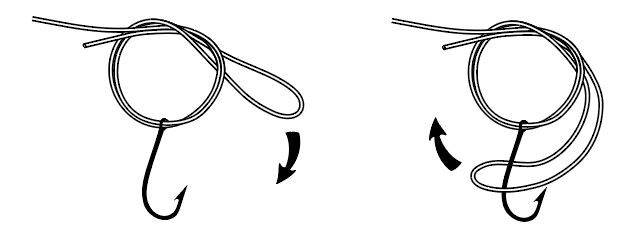 4. Snug the knot tight by pulling on the tag end of the line and the standing end of the line simultaneously.
Tying Tips:
- Proper knot tying takes a bit of practice. It is usually easier to learn a new knot by tying it with heavier fishing line. Even handier for practicing may be soft nylon twine. A short chunk of dowel rod with a screw eye embedded in it makes a handy (and safely hookless) practice “lure” for tying to.
- Give yourself plenty of line to work with. Having too short a “tag end” can make any knot much harder to tie.
- Moistening the knot with a drop of water or saliva will help the line to snug up nicely when the finished knot is tightened, without risk of damage to the line by unnecessary friction. Pull a knot tight with a smooth and even motion, not with a jerk.
- Knots can weaken with stress or use. Check the strength of a knot by pulling hard on the line after landing a fish, or after fishing with the same knot for a while.
 |
|
If you are already following the TrophyCatch Facebook page that's great, but go beyond bass with FWC's FishReelFlorida on Instagram! This social media site covers a variety of freshwater related topics including all species of freshwater fish (and occasional wildlife), fisheries and lake management, top angling locations, fishing, and freshwater ecology. |
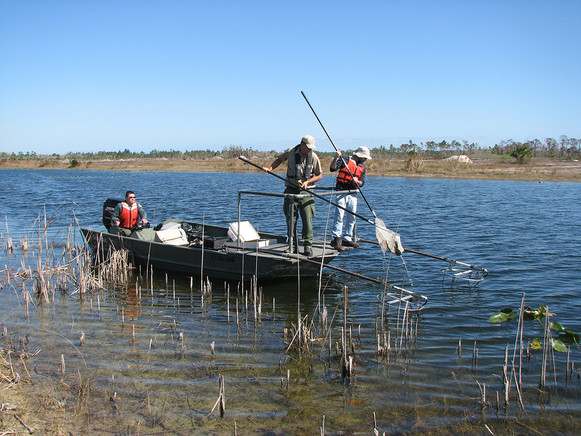 |
When biologists wish to survey a fish population, there are a number of different techniques they can use. While the method selected will depend partly on the species of interest, electrofishing is often chosen as an excellent all-around method for general survey work. Electrofishing has a number of advantages: it targets moderate to large fish (the ones of interest to anglers, of course!), can cover a wide area (unlike a net set in a specific location), and does not harm the fish sampled. Of course, there are disadvantages, too. The electrical field, for example, only extends out to about six feet into the water (restricting survey areas to shallow shoreline zones), and certain species (such as bottom-hugging catfish) are difficult to sample consistently with electrofishing gear. However, the relative ease with which long shorelines can be covered and the susceptibility of most fish to this method makes electrofishing one of the most efficient workhorses in the fisheries biologist’s stable.
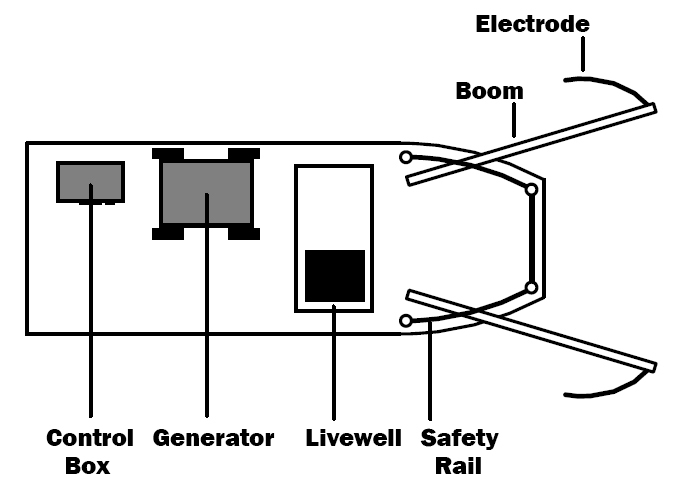 |
Shown here is a typical electrofishing rig. An electrofishing boat is one of the most efficient ways to sample a fish population.
The basic principle is simple enough. Electricity from a generator in the boat passes through electrodes placed in the water off the bow. The electricity is carefully adjusted through a specially-design electrical control box to reduce the chances of harming fish and to achieve maximum effectiveness. At the edges of the electrical field, fish are not stunned but are actually forced to swim toward the source of the electrical current! When fish near the electrode, they are immobilized, often turning belly up. A dip-netter on the front of the boat (protected from falling in by a safety railing) scoops up the fish and places them in an aerated livewell. The fish can then be weighed, measured, or tagged prior to being safely released. Don’t try this at home, though — use of electricity for fishing is illegal without a scientific collecting permit!
Size: 193 acres.
Location: Leon County within the L. Kirk Edwards Wildlife and Environmental Area.
Description: Biologists from FWC’s Division of Freshwater Fisheries Management and the Fish and Wildlife Research Institute teamed up to improve angling opportunities on Lake Piney Z in Tallahassee. Biologists added 48 recycled plastic fishing structures to existing fish attractors back in mid-November 2020. All fish attractors can easily be reached from shore via the lake’s numerous fishing piers. The attractors are all marked with a floating buoy and are securely anchored to the lake bottom with concrete blocks.
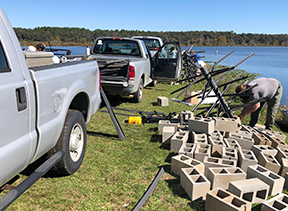
This 193-acre lake is part of the L. Kirk Edwards Wildlife and Environmental Area. Lake Piney Z was recently named as a Top-10 “Mom-Approved” fishing and boating destination in the United States. Lake Piney Z remains a popular fishing destination in the Tallahassee area due to an abundance of shoreline fishing access. Hand-launching of kayaks, canoes, and small jon boats is also permitted (gasoline engines are not allowed). The lake has an abundance of fish species including largemouth bass, black crappie, bluegill, redear sunfish, and catfish. Lake Piney Z also offers various wildlife viewing opportunities, a paddling trail, a walking/biking trail, and many family-friendly amenities.
|
To contact the Florida Freshwater Angler, email John Cimbaro.
|